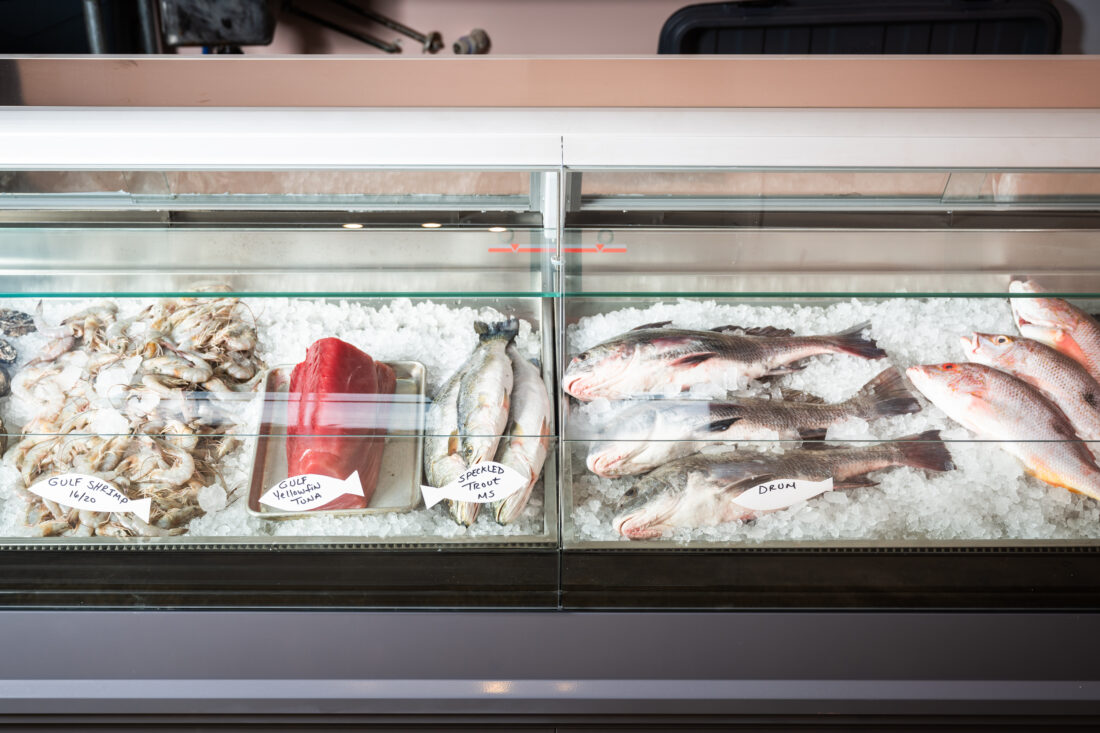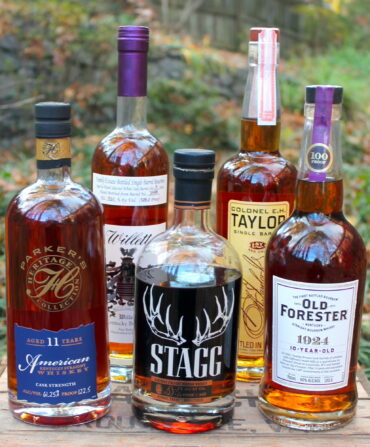I’m probably not the first or only local to remark, “This place feels like it’s been here forever,” upon entering the royal-purple building at the intersection of Bienville and North Carrollton, in New Orleans’ Mid-City neighborhood. The low-slung, brick façade gives way to throwback coastal diner interiors that feel (excuse the pun) hauled out of the 1960s, perhaps borrowed from a well-loved Florida Keys pit stop.

Seafoam green barstools match the tile behind the eight-stool wooden bar. Another six tables sit alongside the pale pink walls, as well as a deep freezer loaded with gumbo and fish stock. The glass case up front is piled high with fresh seafood over ice. Handwritten tags in sharpie call out the offerings: mackerel, blackfin tuna, shrimp, oysters, clams.

A big-flavor, mild-frills joint, Porgy’s Seafood Market, which officially opened in January, is a passion project by four restaurant veterans who wanted a means to address some dire questions facing the seafood industry in the Gulf South. “How do we connect the consumer to the struggles of our Gulf fishing and seafood industries?” says co-owner Dana Honn. “How do we introduce the importance of warming waters and overfishing directly to the customer? And how do we give them a way to purchase and consume what will help restore the balance?”
Joining Honn in the project is his wife and business partner, Christina do Carmo Honn (the pair also run the restaurant Carmo in the Warehouse District). Alongside are co-owners and business partners Marcus Jacobs and Caitlin Carney, who brought the city the now-shuttered Marjie’s Grill and Seafood Sally’s. Chef Wataru Saeki, who moved from Japan to New Orleans decades ago and developed the raw bar at Carmo, helms the kitchen and serves as lead fish butcher. (Get the Porgy’s recipe for Cuban ceviche below.) The group is dedicated to selling only wild-caught, sustainable seafood, and especially to the idea of connecting consumers directly to the region’s multi-generational fishing families.
“Our fishing industry here in the Gulf is in a bad way right now,” explains Dana Honn, a rugged figure with a four-day stubble who can name and describe hundreds of species, detailing each one’s flavor, how and where it swims, and the season when boats might see it running. “If we don’t do something, I believe we could see a complete collapse of the shrimper industry down here in a few years.”
Honn cites a litany of challenges facing fleets, including warmer waters and stronger and more frequent hurricanes, rising costs to small operators struggling to bounce back from the pandemic, and pressure from large conglomerates.
“It’s sixty-five cents per pound for shrimp at the dock right now,” he says. “Five years ago, it was two times that. They can’t even afford fuel at these prices. The multinational companies are already coming in to buy up processing facilities. We need a way to connect the consumer to these amazing fisheries, to protect the deep history of this industry here.”
That’s what the Porgy’s team has set out to do, offering whatever is hauled fresh from local waters that day, extending as far as Florida, where they source clams. And though you’ll find more well-known species like grouper and red snapper, a key to their mission of changing how people think about and consume seafood is providing an outlet for bycatch.
Though sometimes viewed as less favorable, bycatch here refers to lesser-known species that typically arrive in a net meant for something else. Fisherman can’t usually sell a few of something, so these fish are often used as bait or thrown back.

“Porgy is frequently a bycatch on the snapper boats,” Honn explains, as we dig into a fantastic gumbo, buoyant with curled pink shrimp and plenty of oysters and okra. “Another is rainbow runner. That’s a beautiful fish, very elongated, with mild and firm flesh. Where previously these might hit the deck, we are willing to buy them and sell them to our customers.”
Anything featured in the case at Porgy’s can be made into a sandwich or salad, and with each bycatch purchase, the chefs offer helpful advice for cooking it at home. Blackfin tuna is another example. Though less common on menus in the United States, shoved over for the more esteemed bluefin, that’s not the case farther south. “In Cuba, the majority of what they sell and consume is that blackfin, because it’s great,” Honn says. “When we sell and eat bycatch, it gives the overfished species a chance to catch up. Nothing is wasted.”

While deeply connected to present issues, the Porgy’s team also pays respect to those who came before––the original stewards of these waters. Honn hauls a few framed black-and-white photos from the back office that will soon be hung up, with plaques bearing short descriptions alongside QR codes for those wanting to learn more. One features a fishing shack with a sign reading Manila Village, a former Filipino settlement out on Barataria Bay that originated in the 1700s, when Filipino sailors jumped ship off Spanish boats, making their new home in what’s now Jefferson Parish. In another, a group of Black oystermen stand before a boat loaded with boxed bivalves on the Mississippi River.
“People should know where their fish is coming from, who hauled it in, who caught it, and hopefully, the best ways to prepare it,” Jacobs says. “That’s what we’re aiming for. Oh, and we are also aware that this is New Orleans,” he adds with a wink. “There will be a Bushwacker on at all times, rotating frozen cocktails, and a beer and wine-by-the-can program, too.”








